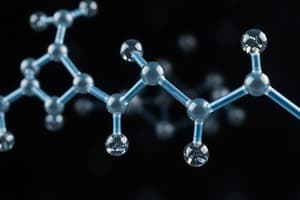Podcast
Questions and Answers
What are biomolecules?
What are biomolecules?
Biomolecules are molecules that occur naturally in living organisms.
Which of the following are examples of biomolecules?
Which of the following are examples of biomolecules?
- Carbohydrates
- Lipids
- Proteins
- Nucleic acids
- All of the above (correct)
Biomolecules can be both small molecules and macromolecules.
Biomolecules can be both small molecules and macromolecules.
True (A)
Biomolecules are composed primarily of carbon, hydrogen, oxygen, nitrogen, and phosphorus.
Biomolecules are composed primarily of carbon, hydrogen, oxygen, nitrogen, and phosphorus.
What are the most abundant organic molecules in nature?
What are the most abundant organic molecules in nature?
Carbohydrates are simply defined as poly-hydroxy aldehydes or ketones and their derivatives.
Carbohydrates are simply defined as poly-hydroxy aldehydes or ketones and their derivatives.
What is the empirical formula of carbohydrates?
What is the empirical formula of carbohydrates?
The hydrogen and oxygen atoms in carbohydrates are always present in the proportion of two hydrogen atoms to one oxygen atom, as in water.
The hydrogen and oxygen atoms in carbohydrates are always present in the proportion of two hydrogen atoms to one oxygen atom, as in water.
All substances containing hydrogen and oxygen in a 2:1 ratio are carbohydrates.
All substances containing hydrogen and oxygen in a 2:1 ratio are carbohydrates.
Carbohydrates are actually or potentially convertible to hydroxyl aldehydes or ketones.
Carbohydrates are actually or potentially convertible to hydroxyl aldehydes or ketones.
In most cases, carbohydrates are poly-hydroxy aldehydes or ketones.
In most cases, carbohydrates are poly-hydroxy aldehydes or ketones.
Flashcards
Biomolecules
Biomolecules
Molecules found in living organisms, forming the basis of life.
Macromolecules
Macromolecules
Large molecules composed of many atoms covalently bonded together.
Biomolecules composition
Biomolecules composition
Organic molecules that contain carbon, hydrogen, oxygen, nitrogen, sulfur, and phosphorus as primary components.
Carbohydrates
Carbohydrates
Signup and view all the flashcards
Carbohydrate definition
Carbohydrate definition
Signup and view all the flashcards
Carbohydrate hydrogen-oxygen ratio
Carbohydrate hydrogen-oxygen ratio
Signup and view all the flashcards
Exceptions to carbohydrate ratio
Exceptions to carbohydrate ratio
Signup and view all the flashcards
Exceptions to carbohydrate composition
Exceptions to carbohydrate composition
Signup and view all the flashcards
Carbohydrate potential
Carbohydrate potential
Signup and view all the flashcards
Common carbohydrate type
Common carbohydrate type
Signup and view all the flashcards
Ring structure of sugars
Ring structure of sugars
Signup and view all the flashcards
Monosaccharides
Monosaccharides
Signup and view all the flashcards
Disaccharides
Disaccharides
Signup and view all the flashcards
Polysaccharides
Polysaccharides
Signup and view all the flashcards
Starch
Starch
Signup and view all the flashcards
Cellulose
Cellulose
Signup and view all the flashcards
Glycogen
Glycogen
Signup and view all the flashcards
Energy source for life
Energy source for life
Signup and view all the flashcards
Structural role of carbohydrates
Structural role of carbohydrates
Signup and view all the flashcards
Cell recognition
Cell recognition
Signup and view all the flashcards
Study Notes
Carbohydrates - General Idea
- Biomolecules are molecules naturally found in living organisms.
- All life forms consist entirely of biomolecules.
- Biomolecules are organic molecules, including macromolecules like carbohydrates, proteins, lipids, and nucleic acids.
- Biomolecules also include smaller molecules like metabolites and natural products.
- Biomolecules primarily contain carbon, hydrogen, nitrogen, oxygen, sulfur, and phosphorus.
- These atoms are covalently bonded.
Carbohydrate - General Idea
- Carbohydrates are the most prevalent organic molecules in nature.
- They're defined as polyhydroxy aldehydes or ketones, or their derivatives.
- Many have the empirical formula (CH₂O)ₙ.
- The formula (CH₂O)ₙ, once suggested that carbohydrates were hydrates of carbon.
- Typically, the hydrogen-to-oxygen ratio in carbohydrates reflects the ratio in water (2:1).
- Not all substances with a hydrogen-to-oxygen ratio of 2:1 are carbohydrates (e.g., acetic and lactic acid).
- Some carbohydrates, like Rhamnose, don't have the 2:1 ratio.
- Carbohydrates are essentially or potentially aldehydes or ketones with multiple hydroxyl groups.
Ring Structure of Sugars
- This is covered in slide 3, which contains images of sugar structures.
Studying That Suits You
Use AI to generate personalized quizzes and flashcards to suit your learning preferences.



